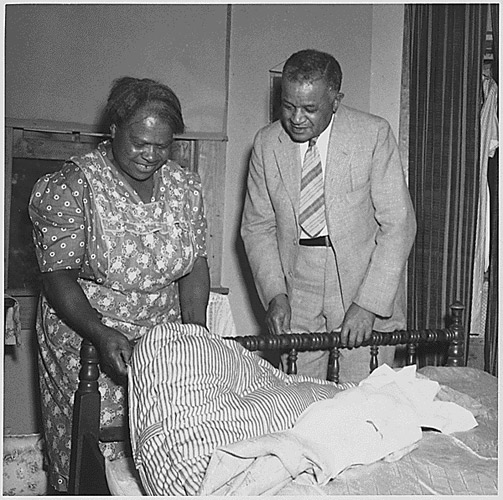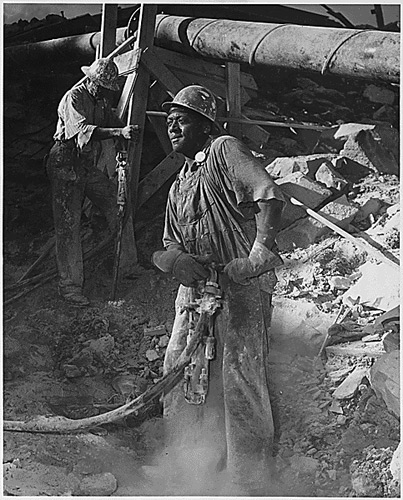SECTION 08
The Great Depression
Surplus cotton mattress.
Source: Franklin D. Roosevelt Presidential Library and Museum, Hyde Park, New York.
While some African Americans were successful in retaining their land and establishing farms, this became more difficult in the 1920s and 1930s. The economic crisis known as the Great Depression actually began in the rural South with a severe crisis in agriculture. Approximately 150,000 African Americans left the state of Georgia in the decade of the 1920s to escape oppressive economic conditions as well as vigilante violence. As the price of cotton fell from eighteen cents in 1929 to only six cents a pound four years later, thousands of blacks once again began to migrate to the Northeast and the Midwestern states.
Federal Emergency Relief Administration camp July 1934.
Source: Franklin D. Roosevelt Presidential Library and Museum, Hyde Park, New York.
Meanwhile, as people fled the economic devastation of the South, jobs rapidly disappeared in the northern and Midwestern cities. African American families were hit the hardest. While white unemployment had hit an extraordinarily high rate of 31.7 percent in 1931, it was well over 50 percent for Black Americans. As the economy spiraled downward, the jobs that black Americans had come North to obtain were given to white workers or eliminated entirely. Furthermore, discrimination in wages meant that black workers suffered significantly in their attempts to provide for their families. Even when families were able to hold onto employment, the low level of income meant poverty for many.
The relief promised by Roosevelt’s administration for a “new deal” held the promise for black people of equitable treatment. African American writers and artists benefited from Roosevelt’s WPA programs, and migrant workers found a new kind of mobility previously unavailable to black laborers. WPA workers spent hours transcribing oral histories done with ex-slaves, the first attempt by the American government to recover this part of the African American experience. World-renowned African American painter Jacob Lawrence was trained and began his career painting as part of a WPA project.
Black jackhammer operator at the Tennessee Valley Authority, June 1942.
Source: Franklin D. Roosevelt Presidential Library and Museum, Hyde Park, New York.
However, Roosevelt, who had been elected in no small part because of the emerging black vote, was ambivalent to taking a stand against segregation, and much of the New Deal’s legislation was administered at a state level, where segregation could be enforced. Although African Americans benefited from New Deal housing programs that would later radically alter black urban living, in the South they were implemented strictly along Jim Crow segregation lines. A compelling example of this egregious racism in the dissemination of relief affected sharecroppers throughout the South. The Agricultural Adjustment Administration paid farmers to destroy their crops and livestock in order to increase market prices. Yet most federal funds, which were meant to benefit black sharecroppers and tenant farmers, ended up in the hands of white landlords as a result of local distribution. As a result, thousands of poor farmers were evicted from their land, while the federal government did little to intervene.
Related Resources
Black jackhammer operator at the Tennessee Valley Authority, June 1942.
During the Great Depression, African Americans were especially hit hard with high unemployment rates. Some found relief however through the Roosevelt administration's "new deal".
Source: Franklin D. Roosevelt Presidential Library and Museum, Hyde Park, New York.
Federal Emergency Relief Administration camp July 1934.
A Federal Emergency Relief Administration (FERA) camp for unemployed Black women in Atlanta, GA. July 1934.
Under President Roosevelt, the federal government created several agencies to assist those hit hardest by the Great Depression. Pictured here is a camp for unemployed black women in Atlanta.
Source: Franklin D. Roosevelt Presidential Library and Museum, Hyde Park, New York.




